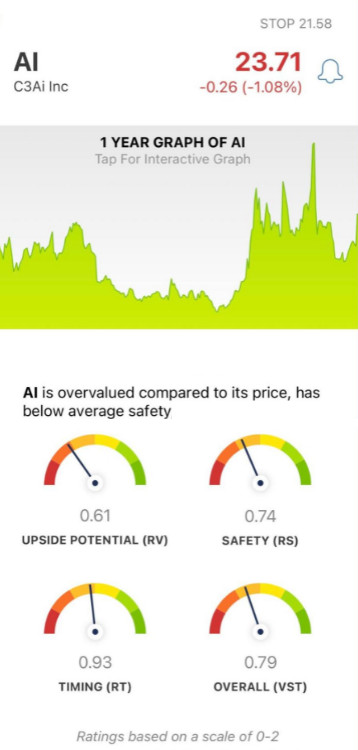20 Handy Ideas For Deciding On Best Stock Analysis Website Sites
20 Handy Ideas For Deciding On Best Stock Analysis Website Sites
Blog Article
Top 10 Ways To Evaluate The Integration And Compatibility Of Ai-Based Stock Forecasting And Trading Platforms
Integrity and compatibility are two of the primary aspects to take into consideration when looking at AI analysis and forecasting platforms for trading. An AI platform that is seamlessly integrated with the processes, tools and systems of your company can increase productivity and efficiency. Here are the top 10 guidelines for evaluating the compatibility and integration of these platforms:
1. Check Brokerage Integration
Supported Brokers: Check that the platform you choose to use is compatible with your preferred broker account or trading platform.
Trade execution: Determine if your platform allows the execution of trades directly through the integrated broker.
Account synchronization: Check to see if the platform you are using is capable of syncing accounts' balances, transactions and positions in real-time.
2. Assess the availability of APIs
API access: Ensure the platform you choose to use has an API (Application Programming Interface), which lets developers create custom tools and automate workflows.
API documentation: Make sure the API provides clear examples of use cases.
Rate limits. Check that the API you're looking at has reasonable rates and can manage your volume of usage.
3. Assessment of Integration Tools from Third Parties
Popular Tools: Ensure that the platform is compatible with other software, like Google Sheets and Excel.
Import and export of data. Make sure your platform can export/import easily from/to other tools.
Plugins/Extensions: Check if your platform is able to support extensions and plugins that can provide additional functionality.
4. Test Compatibility with Operating Systems
Desktop compatibility: Make sure the device is compatible with the OS of choice (Windows, macOS or Linux).
Mobile compatibility. Verify if you are able to download the app for iOS or Android.
Web-based accessibility: To enhance flexibility, verify that the interface for your platform can be accessed through an internet browser.
5. Assess the Data Integration Capabilities
Data sources. Make sure the platform supports multiple data integrations (e.g. data providers for social media, market sentiment, news feeds).
Real-time feeds for data: Verify that the platform allows for real-time integration of data in order to provide up-to date analysis.
Import historical data: Verify whether the platform allows import of historical data to backtest or analyze.
6. Assessment of Cloud and On-Premise compatibility
Cloud-based platform that is accessible from anywhere, with an Internet connection.
On-premises solutions: Determine if you want to deploy the software on your own premises.
Hybrid solutions: See whether the platform supports an hybrid model that combines cloud and on-premise capabilities.
7. Make sure to check for Cross Platform Synchronization
Device synchronization - Ensure that the platform syncs settings and data across all devices (desktops and mobiles).
Verify that changes made to one device are immediately reflected on other devices.
Access offline - Determine whether you have access to information or have limited access to functions when the platform is not accessible.
8. Check for compatibility between trading strategies.
Strategies for trading that are automated or algorithmic ought to be backed by the trading platform.
Custom indicators: Make sure that your platform allows scripts or indicators which are exclusive to you.
Backtesting strategy: Find out if your platform allows you to test trading strategies using historical data.
9. Examine Security and Compliance
Data encryption - Ensure that your system is using encryption for all data both during transit and when it's in storage.
Authentication Check to determine if your platform is compatible with an authenticated method that is secure (e.g. 2-factor authentication).
Regulatory compliance: Verify that the platform meets applicable laws (e.g. GDPR, FINRA or SEC).
10. Test Scalability & Performance
Scalability - Make sure that the platform you choose will meet your ever-growing needs in terms of users and data.
Performance under load: Find out whether your platform can adapt to conditions of high volatility in the market.
Utilization of resources - Make sure that the platform effectively uses system resources such as CPU, memory, or bandwidth.
Bonus Tips
Feedback from users: Read user reviews and testimonials to gauge the platform's integration capabilities.
Trial period: Take advantage of a no-cost trial or demo to test how the platform integrates with other processes and tools.
Support for customers: Make sure the platform provides a solid assistance in the event of integration issues.
These guidelines will help you assess the compatibility and integration capabilities of AI software for analyzing and predicting stocks. This will help ensure that they work seamlessly with your existing platforms and boost your efficiency in trading. Check out the top rated stocks ai examples for site tips including ai investment app, coincheckup, stock analysis websites, investing ai, invest ai, trader ai app, chart analysis ai, ai trader, stock analysis tool, chart analysis ai and more.
Top 10 Tips To Assess The Risk Management Of Ai Stock Predicting/Analysing Trading Platforms
Risk management plays a vital role in any AI-based stock trading platform. It safeguards your investment by limiting the risk of losses and assists you in maximizing profits. Platforms with robust risk management tools will help you navigate the turbulent stock markets and make an informed decision. Here are 10 guidelines on how you can evaluate the risk management capabilities of the platform.
1. Evaluation of Stop-Loss & Take-Profit Features
Level that you can customize: You should be able to customize the levels of take-profit and stop-loss for the individual strategies and trades.
Make sure that your platform supports trailing stop, which adjusts automatically as the market moves towards you.
Guaranteed stop orders: Find out whether the broker offers guaranteed stop-loss orders, which guarantee that your position will be closed at the specified price, even in volatile markets.
2. Assessment Position Sizing Instruments
Fixed amount. Make sure you have the option of defining your positions' sizes as the fixed dollar amount.
Percentage of portfolio: Check whether you can establish the size of your positions in percentages of your total portfolio to manage risk proportionally.
Risk-reward percentage: Examine to see if it is possible to determine the risk-reward ratio for specific strategies or trades.
3. Look for assistance with diversification
Multi-asset trading. Check that your platform supports multiple asset classes such as ETFs, Forex, Options, and Stocks.
Sector allocation check to determine what tools are that can be used to manage and monitor exposure to the sector.
Diversification of geographical risk: Find out if the platform for trading supports international markets in order to spread risk across different geographical areas.
4. Controlling leverage and margins
Margin requirements. Be aware of the margin requirements before trading.
Check for limits on leverage. You can use this feature to limit your risk exposure.
Margin calls - Check whether your platform notifies you of margin calls promptly. This will prevent liquidation.
5. Assessment and reporting of risk
Risk metrics. Make sure that your platform has key risk indicators (e.g. VaR, Sharpe Ratio, Drawdown) that are relevant to the portfolio you are managing.
Scenario Analysis: Check the platform you use allows the capability of generating different market scenarios in order to assess possible risks.
Performance reports: Ensure that the platform offers you comprehensive reports on performance, as well as returns that are adjusted for risk.
6. Check for Real-Time Risk Monitoring
Portfolio monitoring. Make sure that your platform can monitor the risk in real-time of your portfolio.
Alerts and notifications: Verify whether the platform offers real-time alerts on events that are risky (e.g. margin breaches, Stop-loss triggers).
Risk dashboards – Check to see if the platform you are using offers customized risk dashboards. This will give you a better overview of the risks that you face.
7. Conduct a Stress Test and backtest
Stress testing. Make sure that the platform permits you to stress test your strategy or portfolio under extreme market circumstances.
Backtesting. Check whether the platform allows for backtesting. This is the use of historical data to assess risk and performance.
Monte Carlo simulators: Verify that the platform is using Monte Carlo to simulate a number of possible outcomes to allow you to determine the risks.
8. Risk Management Regulations Compliance Assessment
Compliance with regulatory requirements: Make sure the platform is compliant with applicable risk management regulations (e.g., MiFID II in Europe, Reg T in the U.S.).
Best execution: Check if the platform is in line with the best execution practices, making sure that transactions are executed at the most competitive possible price, minimizing slippage.
Transparency Verify the platform's transparency as well as clarity in risk disclosure.
9. Check for User Controlled Risk Parameters
Custom risk rules: Ensure that the platform lets you set up your own risk management rules (e.g. the maximum daily loss, or maximum size of position).
Automated risk control: Determine whether the platform can automatically apply rules to manage risk in accordance with the parameters you've set.
Manual overrides - Examine to see if the platform permits you to manually override automated risk control.
Review user feedback and case research
User feedback: Review the opinions of users to assess the platform's capability to take care of the risk.
Case studies: Look for cases studies or testimonials that highlight the risk management capabilities of the platform.
Community forums - Check to see if the website provides a user-friendly community which is active and where traders can share their strategies for managing risk.
Bonus Tips
Free trial period: Experience the risk management capabilities of the platform in real-world scenarios.
Support for customers: Make sure that the platform can provide solid support for questions or concerns relating to risk management.
Educational resources - Find out whether the platform provides instructional resources and videos on best practices in risk management.
By following these tips and techniques, you will be able to assess the risks management capabilities of AI platform for analyzing and predicting stocks and ensure you select one that will protect your capital and minimize possible losses. It is vital to use a robust risk management tool to be able to navigate volatile markets. Follow the best ai stock price prediction info for more info including ai trader, ai stock trading, best ai trading app, copyright financial advisor, investment ai, best stock analysis app, ai copyright trading bot, stock analysis app, ai investment app, best ai stock trading bot free and more.